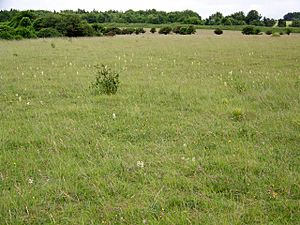Martin and Tidpit Downs facts for kids
| Site of Special Scientific Interest | |
 |
|
| Area of Search | Hampshire |
|---|---|
| Interest | Biological |
| Area | 367.5 hectares (908 acres) |
| Notification | 1987 |
| Location map | Magic Map |
Martin and Tidpit Downs is a very special natural area located north-west of Fordingbridge in Hampshire, England. It covers about 367.5 hectares (908 acres), which is roughly the size of 900 football fields! This site is protected because it has important plants, animals, and geological features.
It is known as a Site of Special Scientific Interest (SSSI), which means it's one of the best places in the country for wildlife and natural features. A large part of it, called Martin Down, is also a National Nature Reserve (NNR). This means it's a top spot for nature conservation. An ancient earthwork called Bokerley Dyke runs through the site, adding to its historical importance.
What Makes Martin and Tidpit Downs Special?
Martin and Tidpit Downs is a mix of different natural areas. You can find chalk grassland, which is a type of grassy land on chalky soil. There are also areas of heath and scrubland. These different habitats help many kinds of plants and animals to live here.
The site is very important for its rich variety of wild herbs and flowers. To help these plants grow, sheep are allowed to graze here. This grazing helps to keep the grass short and stops bigger plants from taking over, allowing smaller, rarer herbs to thrive.
Amazing Butterflies
One of the most exciting things about Martin and Tidpit Downs is its incredible number of butterflies. Scientists have recorded 36 different kinds of butterflies here! This makes it a fantastic place to see these beautiful insects.
Some of the special butterflies you might spot include:
- Marbled white
- Dark green fritillary
- Silver-spotted skipper
- Duke of Burgundy
These butterflies need specific plants and conditions to survive, and Martin and Tidpit Downs provides the perfect home for them.
Ancient History and Bokerley Dyke
This area is not just important for nature; it also has a rich history. You can find many very old earthworks here, which are structures made from earth by people who lived long ago.
The most famous of these is Bokerley Dyke. This is a huge, long ditch and bank that was built in prehistoric times. It's so important that it's protected as a Scheduled Monument. This means it's a nationally important historical site, just like ancient castles or Roman ruins. Walking along Bokerley Dyke gives you a glimpse into the distant past of this landscape.

